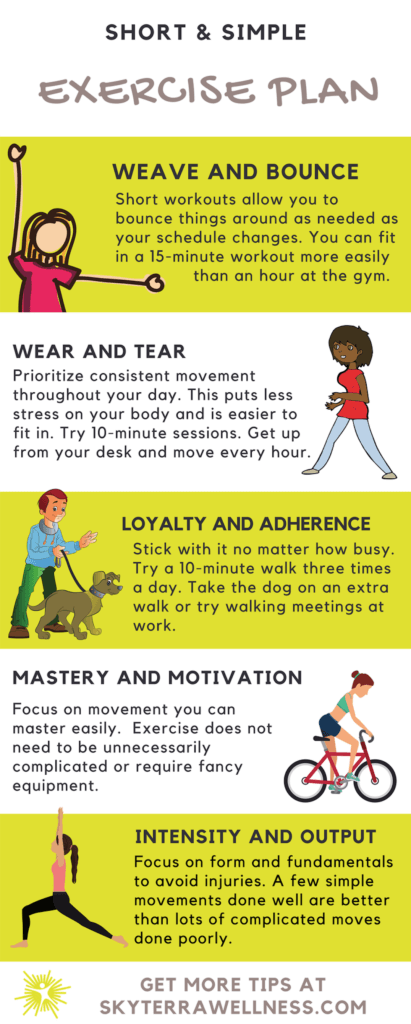You Always Win with Short and Simple Exercise Plans

Do you struggle to maintain your fitness routine? When something in your day goes off-track, is workout time the first thing you throw out the window?
In their bestselling book, The One Thing, authors Gary Keller and Jay Papasan propose a bold idea that may give you a clue as to why you find it impossible to balance all the things going on in your life: a balanced life is a lie. It’s a grand idea, but it’s not very practical, because the key to running your life smoothly is not balance. Your personal time, relationships, health, and work all deserve your absolute, undivided attention. When you’re doing one, you can’t be doing the other. Your focus needs to shift during the course of your day and throughout your week. Competing responsibilities mean something always takes precedence over another. Therefore, your life is never going to be perfectly balanced. How could it be? Instead of balance, Keller and Papasan assert, what you should seek is counter-balance.
What life really comes down to is establishing priorities and making sure the way you spend your time reflects those priorities. Do you protect the time you block out in your schedule for each area of your life? How much time and energy do you spend on areas you deem most important? Do you distribute your time and energy the way you want?
The first step toward bringing your schedule and priorities into harmony is to conduct an honest, objective assessment: if the facts on the ground don’t match the ideals in your head, then it’s time to change things up. We all have a to-do list that’s a mile long. Family, work, and personal time tend to be the first three things on the list, and that makes perfect sense. When push comes to shove, though, the first thing to get kicked off the bottom is personal time—and that means workout time. It shouldn’t be that way, because working out and staying healthy enrich both your family and work life. But where can you find the time to squeeze exercise into your routine, without impacting family and work? It’s a problem almost every adult faces week in and week out.
There’s a solution—and it’s easier than you think. The key to counterbalancing your fitness routine and your responsibilities is to keep your workouts short and simple.
 Keep Them Short
Keep Them Short
Weave and Bounce
When workout sessions don’t take up too much time, they’re easy to reschedule. Short workouts allow you to bounce things around as needed, especially when you’re caught off guard at work or you need to dedicate more time to friends and family when they need help. Exceptional performers roll with the punches and find ways to make up their workouts because they’ve made working out a priority. Short and efficient sessions allow you to keep exercise on your to-do list. Very few people really look forward to grueling 90 minute workouts anyway—when you cut them back to 30 minutes or less, you eliminate excuses and make them something you enjoy.
Wear and Tear
The days of the long workout are over. If you prioritize consistent movement throughout your day, you don’t need the old-school sessions that last for hours. You can get the results you’re after by performing functional compound exercises and keeping your reps under two hundred. It’s easy to find circuit based routines that take less than fifteen minutes and help you achieve your goals just as well as more time-consuming approaches that take an hour or more to complete. Also, short workouts put less stress on your body and dramatically decrease your risk of injury. The wear and tear that leads to problems often results from a combination of factors: you overdo it in the gym, sacrifice sleep for workouts, and forget to address the cumulative stress from other areas of your life. It all matters and it all counts. Short workouts free up time for you to keep your life in order.
Loyalty and Adherence
Research tells us 50% of people who start an exercise program tend to drop it within 6 months. Contributing factors include lack of enjoyment, self-consciousness, and the nature of the fitness goals. One thing is certain, however: keep your workouts short and you’re more likely you stick to them. And you won’t be missing out on anything, either. A study published in 2001 found that overweight women who performed aerobic exercises three times a day for 10 minutes improved their aerobic fitness just as much as those who exercised once a day for 30 minutes. Not only that, they lost almost the same amount of weight. This means that even if you can’t find one 30-minute window during your busy schedule, you can achieve the same results by breaking it up into three 10-minute segments.
You can do that, no matter how busy you are.
All grown adults know life doesn’t always happen according to plan. During the course of any day or week, things come up. You have to adapt and overcome. You have to weave and bounce. If you don’t, you’ll spend half your time frustrated. Short workouts are easy to change around on-demand, which safeguards your workout time. It’s easier to stick to a plan built around short workouts, too. Lose 30 minutes one morning? Make it up with 15 minutes that evening and another 15 the next day. Problem solved.
But will you completely win just by keeping your sessions short? Of course not: they also have to be simple.
Keep Them Simple
Mastery and Motivation
The more complex something is, the harder it is to learn. This applies across the board, and it’s especially true when you’re a grown adult learning to change your behavior. Too many diets and exercise routines are unnecessarily complicated, and it’s virtually impossible to make it through a meal or a workout without referring back to the instructions. If you’re like most people, life will throw you plenty of curveballs on its own. It’s unreasonable to ask yourself to maintain—much less master—a new behavior over the long run if it’s difficult to understand. My point here is that life is challenging enough as it is. There’s no need to make things harder on yourself by trying to implement a complex diet or exercise routine.
You can sidestep this entire problem by keeping your workouts simple. Simplicity also helps with your motivation. It feels great to pick up a new skill quickly, without going through a frustrating learning process. Daniel Pink, author of the book Drive, describes mastery as the desire to get better and better at doing things. A sense of progress, not just in our work, but also in our capabilities, contributes to our inner drive. This means sticking to your plan and getting better at it. At Skyterra, we start our guests with five essential strength training movements and teach them to the point of mastery. People feel a sense of progress after just one training session. These movements are the essence of what I’m talking about: they’re simple, practical, and functional. They relate to daily living activities, they can be done anywhere, and they’re compound—meaning they work several groups of muscles at once and involve two or more joints. Basically, if you learn these five movements you’re set for life.
Intensity and Output
Perfecting your technique on rock-solid fundamental movements increases your confidence in a short period of time. Confidence plays a big part in creating habits that stick. Because let’s face it: starting an exercise program can be intimidating. People are afraid of getting injured. They’re afraid of falling. Often, they’re afraid of confronting what they see as weakness in their bodies. The worst fear people have, though, is the fear of failure. Consider someone who—for a variety of reasons—has never been able to maintain a consistent workout routine. They question their physical abilities and have doubts about whether or not a new approach will work. That’s why simple workouts designed around core movements are best. People master the exercises and make progress quickly, which builds confidence, which turns into consistency.
Consistency makes you feel great. When you combine it with something you feel good about doing, something you feel like you’re good at, you can then ramp up your intensity. Your confidence spurs you onward. It allows you to work harder, increase your speed, and add to your overall workload. At Skyterra, this is how we like it. We don’t muddy the waters. We keep workouts stripped down to three or four fundamental movements. We live by this prescription. During one of our sessions, you don’t spend time stressing about your form because you’ve got it down. You can switch back and forth between movements faster than you ever have before. We don’t go crazy with variations, even though it’s the trendy thing to do right now in the fitness world. We change it up and keep it interesting, of course, but when there are fewer moves to remember, it’s easier and safer to increase the intensity, which is what you’re really after. This is critical if you’re just starting out.
Short and Simple: Wash, Rinse, Repeat—Shine!
When you apply these principles to your routine at home or at the gym, everything gets better. You work harder. You don’t overthink. You don’t get lost. You don’t worry if you’re doing it right. You simply do your workout and get stronger, happier, and fitter, day by day, week by week.
If your current routine is too long and your overall plan is too complicated, you can fix it. Start by asking yourself these two questions:
Can I do this for the rest of my life?
Do I want to do this the rest of my life?
If the answer to either question is unclear, then go back to the drawing board with this in mind: you always win with short and simple.